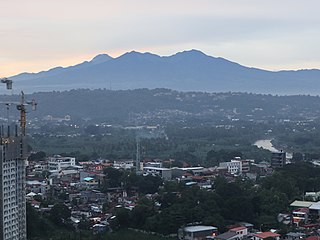
Mount Apo, also known locally as Apo Sandawa, is a large solfataric, dormant stratovolcano on the island of Mindanao, Philippines. With an elevation of 3,144 meters (10,315 ft) above sea level, it is the highest-mountain in the Philippine Archipelago, Mindanao and 24th-highest peak of an island on Earth. Located on the tripartite border of Davao City and Davao del Sur in the Davao Region, and Cotabato in Soccsksargen, Mount Apo is the most-prominent mountain in the Philippines. The peak overlooks from Davao City 45 kilometers (28 mi) to the northeast, Digos 25 kilometers (16 mi) to the southeast, and Kidapawan 20 kilometers (12 mi) to the west. It is a protected area and a Natural Park of the Philippines.
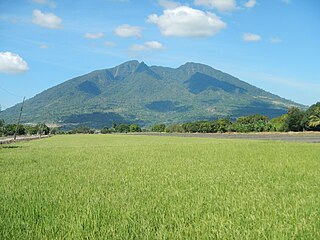
Mount Arayat is an isolated potentially active stratovolcano in the Central Luzon plains, Philippines. Located within vast agricultural lands of Pampanga province, it rises prominently to a height of 1,033 metres (3,389 ft) above sea level. Its southern half lies within the municipality of Arayat, while its north half and summit lies within Magalang. Ten miles (16 km) to the west of Mount Arayat is Angeles City and the former Clark Air Base. The active volcano Mount Pinatubo is located 26 km (16 mi) west, while Manila is located 75 km (47 mi) to the south. Mount Arayat was officially declared a national park in 1933 and a tourist spot in 1997. The mountain is currently under an immense deforestation threat.

Mount Guiting-Guiting is the highest mountain in the province of Romblon, located in Sibuyan Island, in the Philippines, with an elevation of 6,752 ft (2,058 m) above sea level. Its steep slopes and jagged peak, have earned it a reputation as one of the most technically challenging mountains to climb in the Philippines. It is ranked as the 11th-most prominent mountain in the Philippines, and 71st-highest peak of an island in the world. Located at the heart of Sibuyan, it dominates the landscape for miles around. Guiting-Guiting, in the Romblomanon dialect means "jagged". It is one of the focal points of Sibuyan's declaration as a biodiversity haven and has been dubbed by some local and international natural scientists as The Galapagos of Asia. The island of Sibuyan has often been compared with the biodiversity endemism rate of the Galapagos islands in Ecuador. This high endemism prompted much of the mountain and its slopes to be protected in 1996 as the Mt. Guiting-Guiting Natural Park. The park also encompasses the nearby 789-metre (2,589-ft) high Mount Nailog to the west.

Mount Banahaw is an active complex volcano on Luzon in the Philippines. The three-peaked volcano is located at the boundary of Laguna and Quezon provinces. It is the highest mountain in both provinces and Calabarzon region, dominating the landscape for miles around.
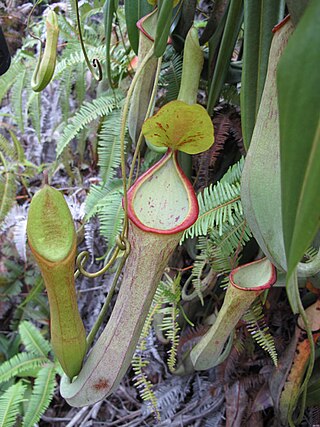
Nepenthes macrovulgaris, or the serpentine pitcher-plant, is a tropical pitcher plant endemic to Borneo. It is a lowland plant that typically grows at altitudes ranging from 300 to 1200 m in sub-montane forest clearings and mossy forest. Its range is restricted to ultramafic habitats, including Mount Kinabalu, Mount Tambuyukon, the Danum Valley, the Tawai Range, the Meliau Range and Mount Silam, all in Sabah, Malaysian Borneo. Pitchers grow to around 25 cm high and range in colour from green to brown, with the speckled form being the most common.

Nepenthes philippinensis is a tropical pitcher plant endemic to the Philippines. It is known from Palawan and the neighbouring Calamian Islands and Linapacan, where it grows at 0–600 metres (2,000 ft) above sea level.

Nepenthes mira is a highland pitcher plant endemic to Palawan in the Philippines. It grows at elevations of 1550–1605 m above sea level.
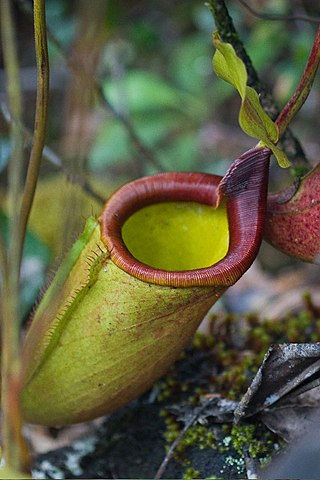
Nepenthes deaniana is a tropical pitcher plant endemic to the Philippines, where it grows at an altitude of 1180–1296 m above sea level. The species is known only from the summit region of Thumb Peak, a relatively small, ultramafic mountain in Puerto Princesa Province, Palawan.
Erwin "Pastor" Emata is a mountain climber and a runner from the Philippines. In 2006, he became the second Filipino to climb Mount Everest. His achievement was recognized by then Philippine President Gloria Macapagal-Arroyo when she conferred Emata with the Order of Lakandula with the special class of Champion for Life.
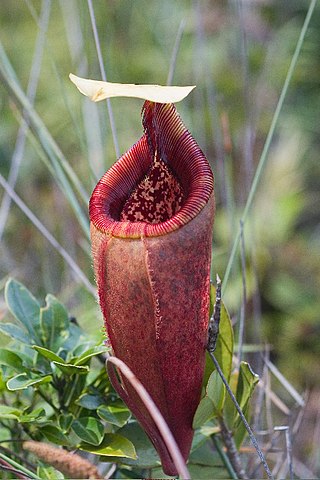
Nepenthes mantalingajanensis is a tropical pitcher plant known only from the summit region of Mount Mantalingajan, the highest point on the Philippine island of Palawan, after which it is named.
Mount Victoria, or Victoria Peaks, is a mountain in central Palawan, Philippines, that lies within the administrative Municipality of Narra. The mountain, which includes the twin peaks known as "The Teeth", as well as the single prominence known as Sagpaw, form the largest contiguous land area and second highest portion of the Mount Beaufort Ultramafics geological region, a series of ultramafic outcrops of Eocene origin, that includes Palawan's highest peak, Mount Mantalingahan.

Mount Mantalingahan is the highest mountain in the island province of Palawan in the Philippines, with an elevation of 6,844 ft (2,086 m) above sea level, its ranked 68th-highest peak of an island on Earth and 10th-most prominent mountain in the Philippines. Located in the southern part of Palawan Island that forms the highest part of the Beaufort Mountains Ultramafics geological region, a series of ultramafic outcrops of Eocene origin, of which Mount Victoria forms the largest contiguous land area. The peak of the mountain is the highest point on Palawan island.
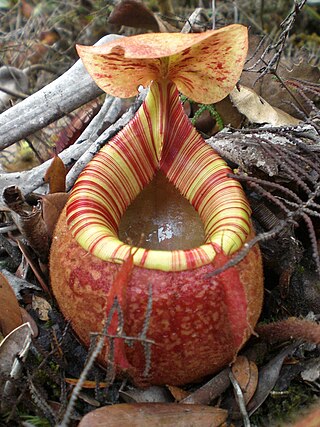
Nepenthes peltata is a tropical pitcher plant known only from the upper slopes of Mount Hamiguitan on the island of Mindanao in the Philippines. It is characterised by a peltate tendril attachment and conspicuous indumentum. The species typically produces ovoid pitchers with a prominent basal crest and large nectar glands on the lower surface of the lid.
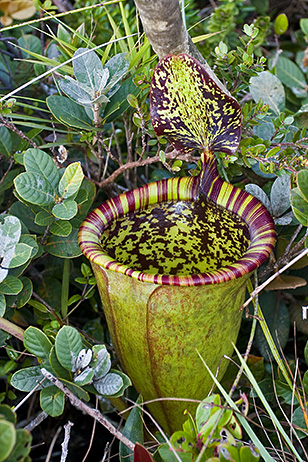
Nepenthes attenboroughii, or Attenborough's pitcher plant, is a montane species of carnivorous pitcher plant of the genus Nepenthes. It is named after the celebrated broadcaster and naturalist Sir David Attenborough, who is a keen enthusiast of the genus. The species is characterised by its large and distinctive bell-shaped lower and upper pitchers and narrow, upright lid. The type specimen of N. attenboroughii was collected on the summit of Mount Victoria, an ultramafic mountain in central Palawan, the Philippines.

Alastair S. Robinson is a taxonomist and field botanist specialising in the carnivorous plant genus Nepenthes, for which he is regarded as a world authority. He is currently Manager Biodiversity Services at the National Herbarium of Victoria, Royal Botanic Gardens Melbourne, where he oversees identification botany services, the Library and Artwork components of the State Botanical Collection, and the botanical journal Muelleria, a peer-reviewed scientific journal on botany published by the Royal Botanic Gardens Victoria, for which he is Editor in Chief.
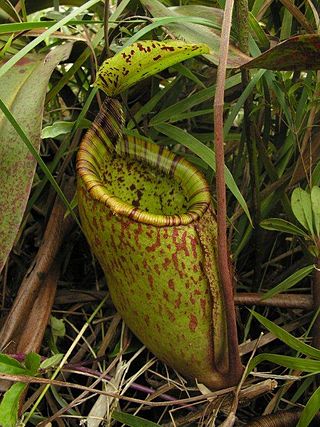
Nepenthes palawanensis is a tropical pitcher plant endemic to Sultan Peak on the island of Palawan in the Philippines, where it grows at elevations of 1,100–1,236 m (3,609–4,055 ft) above sea level. It was discovered in February 2010 by Jehson Cervancia and Stewart McPherson.
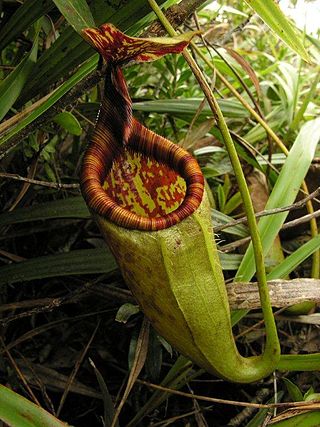
Nepenthes gantungensis is a tropical pitcher plant known from a single peak on the Philippine island of Palawan, where it grows at elevations of 1600–1784 m above sea level.
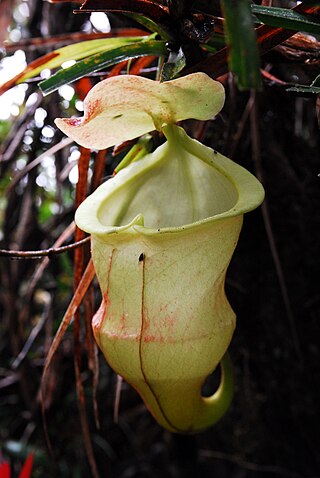
Nepenthes hamiguitanensis is a tropical pitcher plant endemic to a single peak on the Philippine island of Mindanao, where it grows at elevations of 1200–1600 m above sea level. Once thought to be a natural hybrid between N. micramphora and N. peltata, this plant is now considered a species of possible hybridogenic origin. It produces squat upper pitchers that vary greatly in pigmentation, from red speckled to yellow throughout.

Nepenthes leonardoi is a tropical pitcher plant known from a single locality in central Palawan, the Philippines. It is closely allied to several other Palawan endemics, including N. deaniana, N. gantungensis, and N. mira. The traps of this species reach at least 24 cm in height. Some specimens are noted for producing very dark, almost black, upper pitchers.

Nepenthes erucoides is an ultramaficolous tropical pitcher plant endemic to Mount Redondo, the highest peak on the Philippine island of Dinagat, where it occurs from c. 800 meters up until the summit at 929 meters. It grows on a very thin substrate consisting of "lateritic nickel ore and decomposed chromite rubble, through to a clay derived thereof", which has been described as the most extreme ultramafic substrate known to host Nepenthes. Its taxonomic affinities are unclear, though it has been noted for its similarities to N. mantalingajanensis from Palawan. The species' ultramaficolous ecological setting has permitted the radiation of a peculiar set of associated traits, those being: "reduced leaf morphologies, sclerophyllous characteristics, hirsuteness and small stature", which have been associated similarly with the diminutive Nepenthes argentii of the windswept, ultramafic peak of Mount Guiting-Guiting, Sibuyan. The authors suggest that morphological analogues in the aforementioned species do not entail genetic association, and as such these may be considered as instances of morphological convergence- derived from associated conditions in ultramaficolous ecology- until further genetic analysis occurs. Nepenthes erucoides co-localizes with N. mindanaoensis and N. bellii. Nepenthes truncata occurs within the extent of the elfin forest below the 800 meter elevation band, N. merrilliana occurring regionally at elevations below 600 meters.



















